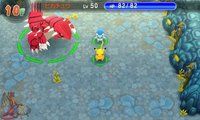|
|

|
PLATFORM
|
3DS
|
BATTLE SYSTEM
|

|
INTERACTION
|

|
ORIGINALITY
|

|
STORY
|

|
MUSIC & SOUND
|

|
VISUALS
|

|
CHALLENGE
|
Very Easy
|
COMPLETION TIME
|
20-40 Hours
|
|
OVERALL

|
+ Packs a lot of content
+ Easy to grasp
- Story is generic and forgettable
- Gameplay fails to evolve in meaningful ways
|
Click here for scoring definitions
|
|
|
Pokémon has been around long enough and had enough of a lasting impact that even its spin-off franchises are beginning to feel like part of an old guard. The Pokémon Mystery Dungeon series in particular is a decade old and spans three handheld generations, transitioning with its parent series as it moved from humble 2D origins to the more modern 3D look. With the latest release, Pokémon Super Mystery Dungeon, Spike Chunsoft attempted to create a definitive Pokémon game as well as an accessible Mystery Dungeon game that best encapsulates where the proper series is now. For better or worse, it succeeded.
Pokémon Super Mystery Dungeon takes place in an even more fantastical world where Pokémon live together in a very organized — as if by humans — world that seems preeminently occupied with adventuring. While the Pokémon live out their simple lives, the originally-human player character wakes up as a Pokémon with no memory of who he or she was beforehand and quickly angers some unfriendly Beheeyem. Fortunately, a friendly Nuzleaf comes along and lets the human-turned-Pokémon hide out in the quiet Serene Village. It is here that the player meets their partner, chosen by the player, and the two begin a journey that will take both of them across the entire world and even space and time.
This journey begins with the traversal of mystery dungeons. Mystery dungeons are the randomized dungeons that make up the bulk of the game, cluttered with enemy Pokémon, traps, items, and, most importantly, the staircase leading down or up to the next floor. Every action made in the dungeon gives every other character a single action as well, whether that action be move, attack, use and item, etc. In this way, exploration is just as turn-based as the combat is. The dungeons vary in theme and design, but for the most part play out exactly the same way every time. While exploring, the lead Pokémon as controlled by the player will slowly become hungrier, taking continual damage once its stomach is empty. However, simply carrying around a few apples is usually enough to prevent this causing any problems.
 Being able to pick from all starters, plus Pikachu and Riolu, is a welcome addition.
Being able to pick from all starters, plus Pikachu and Riolu, is a welcome addition.
|
|
Given that the dungeons are randomized, there is little rhyme or reason to their layout, opting instead for long, wandering corridors and scattered rooms that are as likely to contain a helpful item as they are an enemy or dead end. Without certain equipment, traps are an inevitability, but most hit at a time when it is not dangerous to do so and mostly just make serve as a minor annoyance along the way. Occasionally, one of the numerous weather effects will cover the floor and will adversely affect Pokémon whose type doesn't match, but these tended to be few and far between. Even with the visual changes accompanying different dungeons, the actual crawl will becomes very rote after only a few trips.
The greatest variety the game has to offer are the Pokémon themselves. Players can put together teams of up to three Pokémon, with occasional guest Pokémon sometimes putting that number higher. Pokémon share many of the same traits as they do in their base games, such as typing and move sets. Like the main games, Pokémon can have four moves memorized and can learn new ones through levelling and TMs. Moves have a limited number of uses (PP) and when depleted the Pokémon is left with a stunted "feint" that can double as an attack, but does so little damage its basically worthless for anything other than passing the current Pokémon's turn. Many of the moves try to make the translation from the main games to the Mystery Dungeon series, but a lot of the moves end up feeling the same.
Recruiting new members works differently compared to previous entries. Rather than befriending Pokémon at random by defeating them in dungeons, the Connection Orb is introduced. Replacing the quest board, the Connection Orb acts like a big constellation with each star representing a Pokémon in need. By accepting and completing their request, that Pokémon will become friends and be able to join the team for missions, as well as opening up new requests for anyone they were connected too. It's a more straightforward method of building the team, though who is available and when is another example of this game being quite easy. It wasn't three hours before I unlocked Salamence, who happened to be fifty levels higher than my two mains at the time. Thinking it had to be a joke, a tried to take him with me on the next mission. Lo and behold, a level 55 Salamence wreaked havoc on the poor Caterpies and Oddishes of the earliest dungeons. The game does institute a cooldown between missions for higher level characters, but within the next few hours I had enough high-level allies that they could be effectively rotated without fuss. Still, this does allow the game to feature every Pokémon in it and the bulk of the game will be spent unlocking all of them through the Connection Orb.
 One of these things is not like the other.
One of these things is not like the other.
|
|
Combat remains similar to previous games but with a few changes that continue to make the game even easier. Magic Wands are now a thing Pokémon can use for some reason, clumsily carried over from Mystery Dungeon proper. Using a wand targets the area directly in front of the Pokémon using it and has effects ranging from inducing status ailments to surrounding the targeted Pokémon with the entire party. Combined with orbs, which have similar effects but applied to an entire room instead, wands tend to give the player almost too many options for dealing with problems and make boss fights a cinch. A far more interesting addition are the Emera Looplets. Emera Looplets are notched belts that contain emeras, temporary power-ups that last only as long as the dungeon they are consumed in. When equipped in a looplet they can actually gain unique abilities like increasing stats, adding debuffs to attacks, attacking multiple times in a row, or allowing Pokémon to survive a deadly blow. Finding emeras in dungeons was always interesting and as far as new things go, their inclusion and execution is the best.
Difficulty throughout the entire game is very easy and as such the game progresses through the story mode quite quickly. In fact, this game pushes players through the story with very little downtime between story missions, saving most of the side content for the endgame. For the few times players do get stuck, rescue teams comprised of reserve characters can be sent to recover them, saving the progress through the dungeon and putting the team back at full strength in the process. This process does involve traversing the same through the same dungeon that was just failed so, while convenient, it does nothing to help the game's repetitious problems. On top of that, characters seem to progress incredibly slowly and without evolutions, at least through the story mode, in a very dull manner. My Charmander and Mudkip ended the game at levels 28 and 27 respectively, each learning only a few new moves naturally throughout the game. This feels like it's mainly to accommodate the Connection Orb and having every Pokémon available, but I spent the game wanting to stick by the mains even though there wasn't much incentive to do so.
The story itself is entirely forgettable. It's another rendition of a human turning into a Pokémon, complete with a liberal dose stock RPG characters. The good guys are blandly so, the bad guys are glorified playground bullies, and the big bad is something completely made up for this game and not really Pokémon related at all. Even the main partner is little more than a best friend type, who is defined solely by a "Cool" or "Cute" choice made at the beginning of the game and the fact that he or she is scared of ghosts. Expedition Guild Leader Ampharos tries to add some bumbling to the proceedings, but he seems to be the only character with any life.
There is still a lot here for a Pokémon fan to like. The game comes complete with all the Pokémon series fans love, jokes, cameos, and references to previous games throughout. It also runs and looks great, with the exception of a few monster rooms that make it stutter a bit. However, the series tradition of being too easy comes back in full force and this time around there are not enough changes to convince non-fans to join the party. Mystery Dungeon fans will see a few familiar aspects, but constant safety nets and easy combat will not hold the attention of the challenge-seeking for long. Pokémon Super Mystery Dungeon is as stock as a Pokémon game can be, there's just a lot more stock in it.
Review Archives
|









